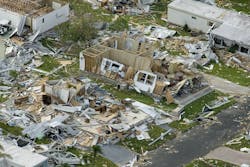Safety Spotlight: Restoring Essential Services During a Pandemic
We have long since crossed the point of no return for preparing to restore essential services during a pandemic, so what are the early lessons? In the initial stages of the pandemic, many utilities leaned on technology to overcome the challenges of physical isolation and held frequent digital meetings. Many of us spent a lot of time together virtually throughout the week with customers and vendors discussing our more immediate plans to keep our employees and the public safe during the blue-sky days of a pandemic. In hindsight, we will all see this as a very successful collaboration, a true team of teams effort. Once best management practices and business continuity plans had been implemented to stabilize the industry and continue providing essential services, we were able to run more "what if?" scenarios, including how to manage a major storm event with so many new challenges.
Getting the lights back on after any of the catastrophic events that affect our country has always offered our industry an opportunity to improve. Utilities and utility vegetation management contractors alike have long held post-action debriefings after wildfires, ice storms, hurricanes and so many other events, including the recent derechos. The purpose of these examinations is to find areas to keep our employees safe while improving restoration times for our communities. COVID-19 gives us the chance to apply this knowledge in a forward-thinking manner into uncharted territory. Do we dare venture to say this will be the last pandemic?
Extreme weather-related restoration efforts have taught us how to train and prepare for future catastrophic events like Katrina, Sandy and major western wildfires. Due to these efforts, it is not unusual now to see a region recover from a major winter event or tropical storm inside of 36 hours. Utilities hold dry run storm events throughout their enterprises to and conduct storm drills for contractors embedded on their systems, but how do we apply this training to the pandemic's unknown variables?
The logistics of a massive restoration effort can be intimidating to the uninitiated. Arranging meals and lodging for hundreds of crews who are traveling from outside the service territory is complicated, particularly with the added demand from customers displaced by the weather. The outside assistance also must consider fuel supply challenges and possible mechanical failures to repair. Internally, IT teams make sure their systems are ready to perform and that vendors are trained. Safety is always paramount, and this usually manifests in very few incidents occurring during a restoration. We gather in stadiums and on speedways, packed in very tight groups to both check in and participate in detailed site-specific safe practices and onboardings. Often, we meet crews from out of state in parking lots or on-site for tailgates and work closely alongside each other. I’m sure there have been a few hotel rooms over capacity during previous storms. Face coverings, enhanced hygiene and the physical distance we are now asked to maintain along with broader and varied government restrictions makes this all sound like super spreader events doesn’t it? Fortunately, our industry is adaptable and has pivoted.
This pandemic will provide silver linings for future restorations by answering these questions and more. Once we collectively started digging into the "what if?" scenarios, it became clear that gaining a better understanding of how to prepare was necessary. Where will we be able to find lodging, both on-site and in transit? How will travel bans affect mutual assistance from out of state? The Department of Homeland Security CISA documents on the essential infrastructure workforce is a great resource. Can we strategically stockpile material before an event to help protect our workforce from the virus? Is our culture of safety strong enough that our employees will maintain diligence around these precautions while away in less than ideal conditions? Do we have the support staff in place to manage a remote workforce including customer service and additional dispatchers? How will we integrate visiting crews into our new digital meetings? What if an employee tests positive or develops symptoms during the event?
Storm response is pressure-driven, making the temptation to sidestep strict pandemic protocols a real concern. There is a shared consciousness among our industry that we can overcome this safely and do it correctly. With more people working from home and in many areas a greater need for services like healthcare to be restored faster, the term essential infrastructure workforce carries even more weight. We must hold the line by only accepting that the guidelines in place to protect us are followed. Our communities, customers and families are counting on it. I am personally looking forward to seeing the results of our collective response to this storm season after the pandemic is in the rear-view mirror.
About the Author
Keith Pancake
Keith Pancake is a safety manager serving ACRT and Bermex. He has been involved in the UVM industry for over 10 years. He is an ISA Certified Arborist and Utility Specialist, an NSC certified Defensive Driving Instructor, and the 2018 Utility Arborist Association’s Silver Shield recipient.
